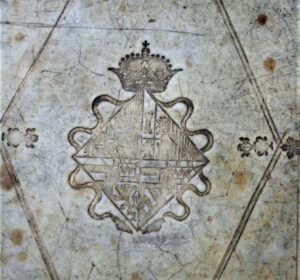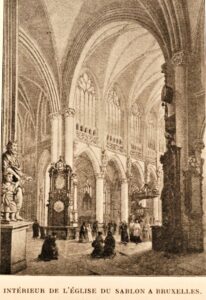Register of the Brotherhood of Saint Joseph
The Brotherhood of Saint Joseph was canonically erected in 1624 in the parish of Our Lady at the Sablon at the request of Archduchess Isabella. She became ruler of the Netherlands on the death of her husband, Archduke Albert, and had joined the Order of Poor Clares.
Pope Urban VIII, best known for his nepotism and the trial against the astronomer Galileo, granted a plenary indulgence to members of the brotherhood. Among the members were a number of famous figures, as can be seen from the register of signatures in the display case. It includes the signatures of Archbishop Jacques Boonen and Cardinal de la Cueva, the Holy See’s legate to the Netherlands. Another member is Ambrogio Spinola, the famous Italian soldier in the service of Spain, who reconquered Ostend in 1604 and then the town of Breda in 1625. The surrender of Breda marked the high point of his career and was immortalised by the Spanish painter Velázquez.
The register also displays the signatures of the Count (Florent) de Berlaymont († 1626) and his wife Marguerite de Lalaing – who founded the convent of the Dames de Berlaymont in Brussels – as well as that of François de Rye († 1637), who was a bishop.
Several religious communities, such as the Abbey of La Cambre, placed themselves under the protection of the saint. The governesses delegated to our country by the Austrian emperors became the protectors of the brotherhood at the Sablon.
Unfortunately, Emperor Joseph II, nicknamed the Sacristan King, suppressed all the brotherhoods and sequestered their assets.
Then came the French occupation. Once the storm had passed, the brotherhood was re-established in 1803. Queen Louise-Marie, the first Queen of the Belgians, and later Queen Elisabeth, successively granted their patronage to the brotherhood. After the Second World War, the lukewarm state of religious life in the country meant that the confraternity, like so many others unfortunately, ceased to exist.

Cover of the register of the Confrérie Saint Joseph with the Habsburg coat of arms.
St Joseph has a magnificent statue, now relegated to the back of the church but formerly at the very front.

The statue is shown here in a French engraving by Alexandre-Jules Monthelier (1804 – 1883). Unfortunately, the sculptor of the statue has not been identified.
